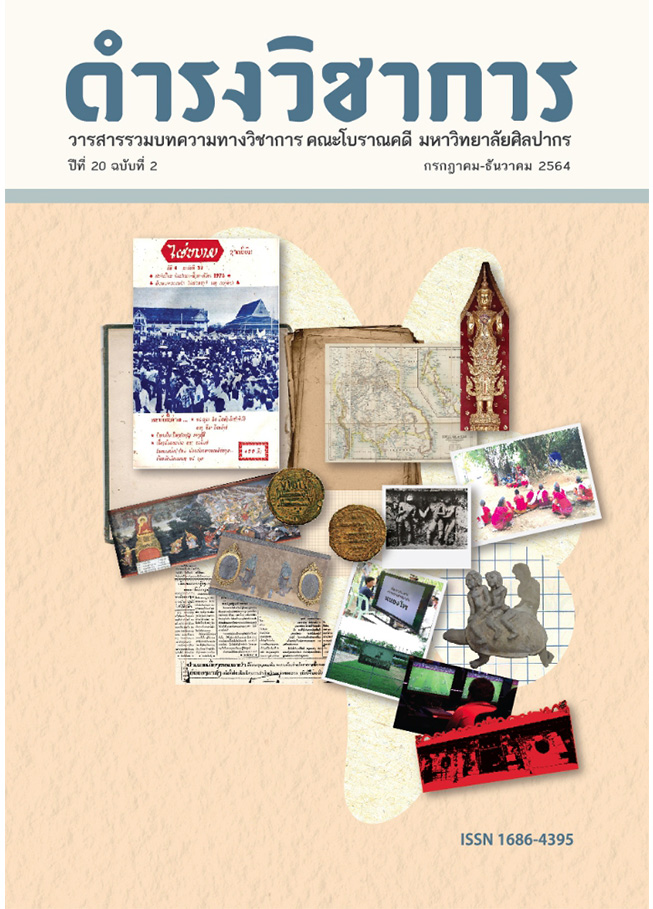การสัมผัสภาษาอังกฤษที่ปรากฏในบทแปลภาษาไทยสองสมัย: กรณีศึกษางานแปลเรื่อง “ความพยาบาท”
คำสำคัญ:
การสัมผัสภาษา, การยืมภาษา, คำยืมภาษาอังกฤษ, การแปล, ความพยาบาทบทคัดย่อ
บทความวิจัยนี้มุ่งศึกษาการสัมผัสภาษาอังกฤษที่ปรากฏในบทแปลเรื่อง “ความพยาบาท” ฉบับภาษาไทยสองสมัย โดยวิเคราะห์ลักษณะการยืมและความเข้มข้นของคำยืมภาษาอังกฤษแบบทับศัพท์เปรียบเทียบกัน ข้อมูลที่ใช้ศึกษาคืองานแปลเรื่อง “ความพยาบาท” ซึ่งแปลจากนวนิยายเรื่อง Vendetta! (1886) ฉบับแรกแปลโดย “แม่วัน” (2445) และฉบับที่สองแปลโดย “ว.วินิจฉัยกุล” (2530) ผลการวิเคราะห์พบว่าคำยืมภาษาอังกฤษแบบทับศัพท์ที่พบมากที่สุดในงานแปลทั้งสองสมัย คือคำที่อยู่ในวงศัพท์สิ่งของที่กินไม่ได้ สำหรับปริมาณของคำยืมภาษาอังกฤษแบบทับศัพท์นั้น งานแปลฉบับ “แม่วัน” มีปริมาณหรือความเข้มข้นของการยืมสูงกว่าฉบับ “ว.วินิจฉัยกุล” คือฉบับ “แม่วัน” มีความเข้มข้น 217 คะแนน ส่วนฉบับ “ว.วินิจฉัยกุล” มีความเข้มข้น 184 คะแนน สรุปได้ว่าการสัมผัสภาษาอังกฤษปรากฏให้เห็นในงานแปลสมัยเก่ามากกว่างานแปลสมัยปัจจุบัน ทั้งนี้เนื่องจากความแตกต่างของยุคสมัย และปัจจัยที่มาจากผู้แปล ผู้อ่าน และภูมิหลังทางสังคม
เอกสารอ้างอิง
ภาษาไทย
แดนบีช แบรดเลย์, 2514. อักขราภิธานศรับท์. กรุงเทพฯ: คุรุสภาลาดพร้าว.
นงลักษณ์ บัณฑุวงศ์, 2560. การใช้คำภาษาต่างประเทศในภาษาไทย. กรุงเทพฯ: คณะมนุษยศาสตร์และประยุกต์ศิลป์ มหาวิทยาลัยหอการค้าไทย.
ปราณี กุลละวณิชย์, 2534. “การเปลี่ยนแปลงของภาษา.” ใน เอกสารชุดวิชาภาษาไทย 3 หน่วยที่ 14 มหาวิทยาลัยสุโขทัยธรรมาธิราช (หน้า 369-436). นนทบุรี: มหาวิทยาลัยสุโขทัยธรรมาธิราช.
ปรารถนา กาลเนาวกุล, 2544. การปนภาษาอังกฤษในภาษาไทยของรายการโทรทัศน์: ลักษณะ ทัศนคติ การรับรู้ และแรงจูงใจ. สงขลา: คณะมนุษยศาสตร์และสังคมศาสตร์ มหาวิทยาลัยสงขลานครินทร์.
มารี คอเรลลี, 2504. ความพยาบาท. (แปลโดย แม่วัน). พิมพ์ครั้งที่ 5. กรุงเทพฯ: องค์การค้าของคุรุสภา ศึกษาภัณฑ์พาณิชย์. (ต้นฉบับพิมพ์เมื่อ 1886, ภาษาอังกฤษ)
___________, 2546. ความพยาบาท. (แปลโดย ว.วินิจฉัยกุล). พิมพ์ครั้งที่ 3. กรุงเทพฯ: สำนักพิมพ์เพื่อนดี. (ต้นฉบับพิมพ์เมื่อ 1886, ภาษาอังกฤษ)
ราชบัณฑิตยสถาน, 2525. พจนานุกรมฉบับราชบัณฑิตยสถาน พ.ศ. 2525. กรุงเทพฯ: อักษรเจริญทัศน์.
วินิตา ดิถียนต์, 2543. เอกสารประกอบการสอนรายวิชาพัฒนาการการแปลในประเทศไทย: การศึกษาเชิงภาษาและวัฒนธรรม. นครปฐม: สถาบันวิจัยภาษาและวัฒนธรรมเพื่อพัฒนาชนบท มหาวิทยาลัยมหิดล.
วิไลลักษณ์ เรืองมานะ, 2546. “การศึกษาเปรียบเทียบนวนิยายแปลเรื่อง ‘ความพยาบาท’ สำนวน ‘แม่วัน’ กับสำนวน ‘ว.วินิจฉัยกุล’.” วิทยานิพนธ์ปริญญาศิลปศาสตรมหาบัณฑิต บัณฑิตวิทยาลัยมหาวิทยาลัยมหิดล.
สกาวรัตน์ คงนคร, 2554. “ลักษณะและการเปลี่ยนแปลงของคำยืมภาษาอังกฤษในภาษาไทย.” วิทยานิพนธ์ปริญญาศิลปศาสตรมหาบัณฑิต คณะมนุษยศาสตร์ มหาวิทยาลัยเกษตรศาสตร์.
สัญฉวี สายบัว, 2540. หลักการแปล. กรุงเทพฯ: สำนักพิมพ์มหาวิทยาลัยธรรมศาสตร์.
สำนักนายกรัฐมนตรี, 2532. ราชกิจจานุเบกษา 106 (153): 439.
สุธิวงศ์ พงศ์ไพบูลย์, 2531. หลักภาษาไทย. กรุงเทพฯ: ไทยวัฒนาพานิช.
สุนันท์ อัญชลีนุกูล, 2549. “คำยืมกับคำต่างประเทศ: เหมือนหรือแตกต่าง.” ภาษาและภาษาศาสตร์ 24 (2): 36-58.
อมรา ประสิทธิ์รัฐสินธุ์, 2546. “ภาษาไทยกับการสัมผัสภาษาอังกฤษที่ปรากฏในพระราชหัตถเลขาพระบาทสมเด็จพระจุลจอมเกล้าเจ้าอยู่หัว.” วารสารอักษรศาสตร์ 33 (1): 48-68.
_________________, 2548. ภาษาในสังคมไทย: ความหลากหลาย การเปลี่ยนแปลง และการพัฒนา. กรุงเทพฯ: สำนักพิมพ์จุฬาลงกรณ์มหาวิทยาลัย.
ภาษาอังกฤษ
Auer P., 2020. “Language contact.” in E. Adamou & Y. Matras (Eds.), The routledge handbook of language contact (pp. 147-167). London: Routledge.
Corelli M., 2014. Vendetta: A Story of one forgotten. Denver: Villainous Press.
Grosjean F., 1982. Life with two languages: An introduction to bilingualism. Cambridge, M.A: Harvard University Press.
Inphen W., 2020. “A dominant global translation strategy in Thai translated novels: The translation of religious markers in Dan Brown’s thriller novels.” Manusya 23 (2): 286-304.
LaPolla R.J., 2009. “Causes and effects of substratum, superstratum and adstratum influence, with reference to Tibeto-Burman languages.” Senri Ethnological Studies 75: 227-237.
Thomason S.G., 2001. Language contact. Washington, D.C.: Georgetown University Press.
Weinreich U., 1953. Languages in contact. The Hague: Mouton.
ข้อมูลอิเล็กทรอนิกส์
ธีรภักดิ์ เชาว์ภักดี, 2560. การใช้ภาษาที่ไม่ชัดเจน. ค้นเมื่อ 15 มิถุนายน 2564, จาก https://e-org.e-tech.ac.th/eorg/depart/thai_social/index.php?option=com_content&view=article&id=133&Itemid=134
The National Identity Office, 2021. Thailand: Traits and Treasures. Retrieved June 15, 2021, from https://oer.learn.in.th/search_detail/result/220987
ดาวน์โหลด
เผยแพร่แล้ว
ฉบับ
ประเภทบทความ
สัญญาอนุญาต
ลิขสิทธิ์ (c) 2021 ดำรงวิชาการ

อนุญาตภายใต้เงื่อนไข Creative Commons Attribution-NonCommercial-NoDerivatives 4.0 International License.
บทความนี้เป็นผลงานของข้าพเจ้าแต่เพียงผู้เดียว และ/หรือเป็นผลงานของข้าพเจ้าและผู้ร่วมงาน ตามชื่อที่ระบุในบทความจริง และเป็นผลงานที่มิได้ถูกนำเสนอหรือตีพิมพ์ที่ใดมาก่อน


